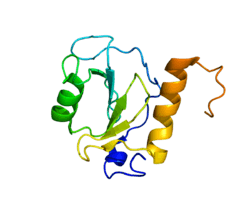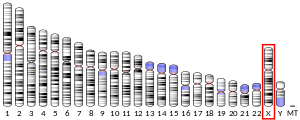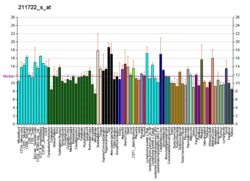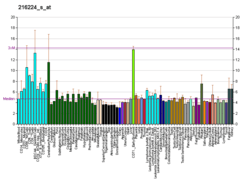HDAC6
Histone deacetylase 6 is an enzyme that in humans is encoded by the HDAC6 gene.[5][6]
Function
Histones play a critical role in transcriptional regulation, cell cycle progression, and developmental events. Histone acetylation/deacetylation alters chromatin structure and affects transcription. The protein encoded by this gene belongs to class II of the histone deacetylase/acuc/apha family. It contains an internal duplication of two catalytic domains that appear to function independently of each other. This protein possesses histone deacetylase activity and represses transcription.[7]
Clinical relevance
Mutations in this gene have been associated to Alzheimer's disease.[8]
Over expression of this protein correlates with tumorigenesis and cell survival. HDAC6 also encourages metastasis of cancer cells.[9]
Functions
Retracts the Cilium of the cell, which is necessary prior to mitosis of the cell.[10]
HDAC also encourages cell motility and catalyzes α-tubulin deacetylation.[11] As a result the enzyme also encourages cancer cell metastasis.[9]
HDAC6 also affects transcription and translation by regulating the heat-shock protein 90 (Hsp90) and stress granules (SGs), respectively.[9]
HDAC6 is also known to bond with high affinity to ubiquitinated proteins.[12] HDAC6 is also required in the formation of SG (Stress granule proteins and is instrumental in SG formation; pharmacological inhibition or genetic removal of HDAC6 abolished SG formation.
Interactions
HDAC6 has been shown to interact with HDAC11[13] and Zinc finger and BTB domain-containing protein 16.[14]
HDAC6 interacts with SG (Stress granule) protein G3BP1.[12]
See also
References
- GRCh38: Ensembl release 89: ENSG00000094631 - Ensembl, May 2017
- GRCm38: Ensembl release 89: ENSMUSG00000031161 - Ensembl, May 2017
- "Human PubMed Reference:". National Center for Biotechnology Information, U.S. National Library of Medicine.
- "Mouse PubMed Reference:". National Center for Biotechnology Information, U.S. National Library of Medicine.
- Grozinger CM, Hassig CA, Schreiber SL (Jun 1999). "Three proteins define a class of human histone deacetylases related to yeast Hda1p". Proc Natl Acad Sci U S A. 96 (9): 4868–73. Bibcode:1999PNAS...96.4868G. doi:10.1073/pnas.96.9.4868. PMC 21783. PMID 10220385.
- Nagase T, Ishikawa K, Suyama M, Kikuno R, Hirosawa M, Miyajima N, Tanaka A, Kotani H, Nomura N, Ohara O (May 1999). "Prediction of the coding sequences of unidentified human genes. XII. The complete sequences of 100 new cDNA clones from brain which code for large proteins in vitro". DNA Res. 5 (6): 355–64. doi:10.1093/dnares/5.6.355. PMID 10048485.
- "Entrez Gene: HDAC6 histone deacetylase 6".
- Cook C, Gendron TF, Scheffel K, Carlomagno Y, Dunmore J, DeTure M, Petrucelli L (5 April 2012). "Loss of HDAC6, a novel CHIP substrate, alleviates abnormal tau accumulation". Human Molecular Genetics. 21 (13): 2936–45. doi:10.1093/hmg/dds125. PMC 3373241. PMID 22492994.
- Aldana-Masangkay GI, Sakamoto KM (2011). "The role of HDAC6 in cancer". J. Biomed. Biotechnol. 2011: 1–10. doi:10.1155/2011/875824. PMC 2975074. PMID 21076528.
- Krishnamurthy K, Wang G, Silva J, Condie BG, Bieberich E (February 2007). "Ceramide regulates atypical PKCzeta/lambda-mediated cell polarity in primitive ectoderm cells. A novel function of sphingolipids in morphogenesis". J. Biol. Chem. 282 (5): 3379–90. doi:10.1074/jbc.M607779200. PMID 17105725. Lay summary – phys.org/news.
- Gao YS, Hubbert CC, Lu J, Lee YS, Lee JY, Yao TP (2007). "Histone deacetylase 6 regulates growth factor-induced actin remodeling and endocytosis". Mol. Cell. Biol. 27 (24): 8637–47. doi:10.1128/MCB.00393-07. PMC 2169396. PMID 17938201.
- Kwon S, Zhang Y, Matthias P (December 2007). "The deacetylase HDAC6 is a novel critical component of stress granules involved in the stress response". Genes Dev. 21 (24): 3381–94. doi:10.1101/gad.461107. PMC 2113037. PMID 18079183.
- Gao L, Cueto MA, Asselbergs F, Atadja P (Jul 2002). "Cloning and functional characterization of HDAC11, a novel member of the human histone deacetylase family". J. Biol. Chem. 277 (28): 25748–55. doi:10.1074/jbc.M111871200. PMID 11948178.
- Chauchereau A, Mathieu M, de Saintignon J, Ferreira R, Pritchard LL, Mishal Z, Dejean A, Harel-Bellan A (Nov 2004). "HDAC4 mediates transcriptional repression by the acute promyelocytic leukaemia-associated protein PLZF". Oncogene. 23 (54): 8777–84. doi:10.1038/sj.onc.1208128. PMID 15467736.
Further reading
- Pazin MJ, Kadonaga JT (1997). "What's up and down with histone deacetylation and transcription?". Cell. 89 (3): 325–8. doi:10.1016/S0092-8674(00)80211-1. PMID 9150131.
- Wolffe AP (1997). "Transcriptional control. Sinful repression". Nature. 387 (6628): 16–7. doi:10.1038/387016a0. PMID 9139815.
- Huynh KD, Fischle W, Verdin E, Bardwell VJ (2000). "BCoR, a novel corepressor involved in BCL-6 repression". Genes Dev. 14 (14): 1810–23. doi:10.1101/gad.14.14.1810 (inactive 2020-01-22). PMC 316791. PMID 10898795.
- Mahlknecht U, Schnittger S, Landgraf F, Schoch C, Ottmann OG, Hiddemann W, Hoelzer D (2001). "Assignment of the human histone deacetylase 6 gene (HDAC6) to X chromosome p11.23 by in situ hybridization". Cytogenet. Cell Genet. 93 (1–2): 135–6. doi:10.1159/000056967. PMID 11474198.
- Kao HY, Lee CH, Komarov A, Han CC, Evans RM (2002). "Isolation and characterization of mammalian HDAC10, a novel histone deacetylase". J. Biol. Chem. 277 (1): 187–93. doi:10.1074/jbc.M108931200. PMID 11677242.
- Seigneurin-Berny D, Verdel A, Curtet S, Lemercier C, Garin J, Rousseaux S, Khochbin S (2001). "Identification of Components of the Murine Histone Deacetylase 6 Complex: Link between Acetylation and Ubiquitination Signaling Pathways". Mol. Cell. Biol. 21 (23): 8035–44. doi:10.1128/MCB.21.23.8035-8044.2001. PMC 99970. PMID 11689694.
- Tong JJ, Liu J, Bertos NR, Yang XJ (2002). "Identification of HDAC10, a novel class II human histone deacetylase containing a leucine-rich domain". Nucleic Acids Res. 30 (5): 1114–23. doi:10.1093/nar/30.5.1114. PMC 101247. PMID 11861901.
- Gao L, Cueto MA, Asselbergs F, Atadja P (2002). "Cloning and functional characterization of HDAC11, a novel member of the human histone deacetylase family". J. Biol. Chem. 277 (28): 25748–55. doi:10.1074/jbc.M111871200. PMID 11948178.
- Hubbert C, Guardiola A, Shao R, Kawaguchi Y, Ito A, Nixon A, Yoshida M, Wang XF, Yao TP (2002). "HDAC6 is a microtubule-associated deacetylase". Nature. 417 (6887): 455–8. Bibcode:2002Natur.417..455H. doi:10.1038/417455a. PMID 12024216.
- Kirsh O, Seeler JS, Pichler A, Gast A, Müller S, Miska E, Mathieu M, Harel-Bellan A, Kouzarides T, Melchior F, Dejean A (2002). "The SUMO E3 ligase RanBP2 promotes modification of the HDAC4 deacetylase". EMBO J. 21 (11): 2682–91. doi:10.1093/emboj/21.11.2682. PMC 125385. PMID 12032081.
- Hook SS, Orian A, Cowley SM, Eisenman RN (2002). "Histone deacetylase 6 binds polyubiquitin through its zinc finger (PAZ domain) and copurifies with deubiquitinating enzymes". Proc. Natl. Acad. Sci. U.S.A. 99 (21): 13425–30. Bibcode:2002PNAS...9913425H. doi:10.1073/pnas.172511699. PMC 129689. PMID 12354939.
- Westendorf JJ, Zaidi SK, Cascino JE, Kahler R, van Wijnen AJ, Lian JB, Yoshida M, Stein GS, Li X (2002). "Runx2 (Cbfa1, AML-3) Interacts with Histone Deacetylase 6 and Represses the p21CIP1/WAF1 Promoter". Mol. Cell. Biol. 22 (22): 7982–92. doi:10.1128/MCB.22.22.7982-7992.2002. PMC 134736. PMID 12391164.
- North BJ, Marshall BL, Borra MT, Denu JM, Verdin E (2003). "The human Sir2 ortholog, SIRT2, is an NAD+-dependent tubulin deacetylase". Mol. Cell. 11 (2): 437–44. doi:10.1016/S1097-2765(03)00038-8. PMID 12620231.
- Voelter-Mahlknecht S, Mahlknecht U (2004). "Cloning and structural characterization of the human histone deacetylase 6 gene". Int. J. Mol. Med. 12 (1): 87–93. doi:10.3892/ijmm.12.1.87. PMID 12792815.
- Brush MH, Guardiola A, Connor JH, Yao TP, Shenolikar S (2004). "Deactylase inhibitors disrupt cellular complexes containing protein phosphatases and deacetylases". J. Biol. Chem. 279 (9): 7685–91. doi:10.1074/jbc.M310997200. PMID 14670976.
- Pandey UB, Batlevi Y, Baehrecke EH, Taylor JP (Nov–Dec 2007). "HDAC6 at the intersection of autophagy, the ubiquitin-proteasome system and neurodegeneration". Autophagy. 3 (6): 643–5. doi:10.4161/auto.5050. PMID 17912024.
- Pandey UB, Nie Z, Batlevi Y, McCray BA, Ritson GP, Nedelsky NB, Schwartz SL, DiProspero NA, Knight MA, Schuldiner O, Padmanabhan R, Hild M, Berry DL, Garza D, Hubbert CC, Yao TP, Baehrecke EH, Taylor JP (June 14, 2007). "HDAC6 rescues neurodegeneration and provides an essential link between autophagy and the UPS". Nature. 447 (7146): 859–63. Bibcode:2007Natur.447..860P. doi:10.1038/nature05853. PMID 17568747.
External links
- HDAC6+protein,+human at the US National Library of Medicine Medical Subject Headings (MeSH)
- HDAC6 human gene location in the UCSC Genome Browser.
- HDAC6 human gene details in the UCSC Genome Browser.
This article incorporates text from the United States National Library of Medicine, which is in the public domain.







